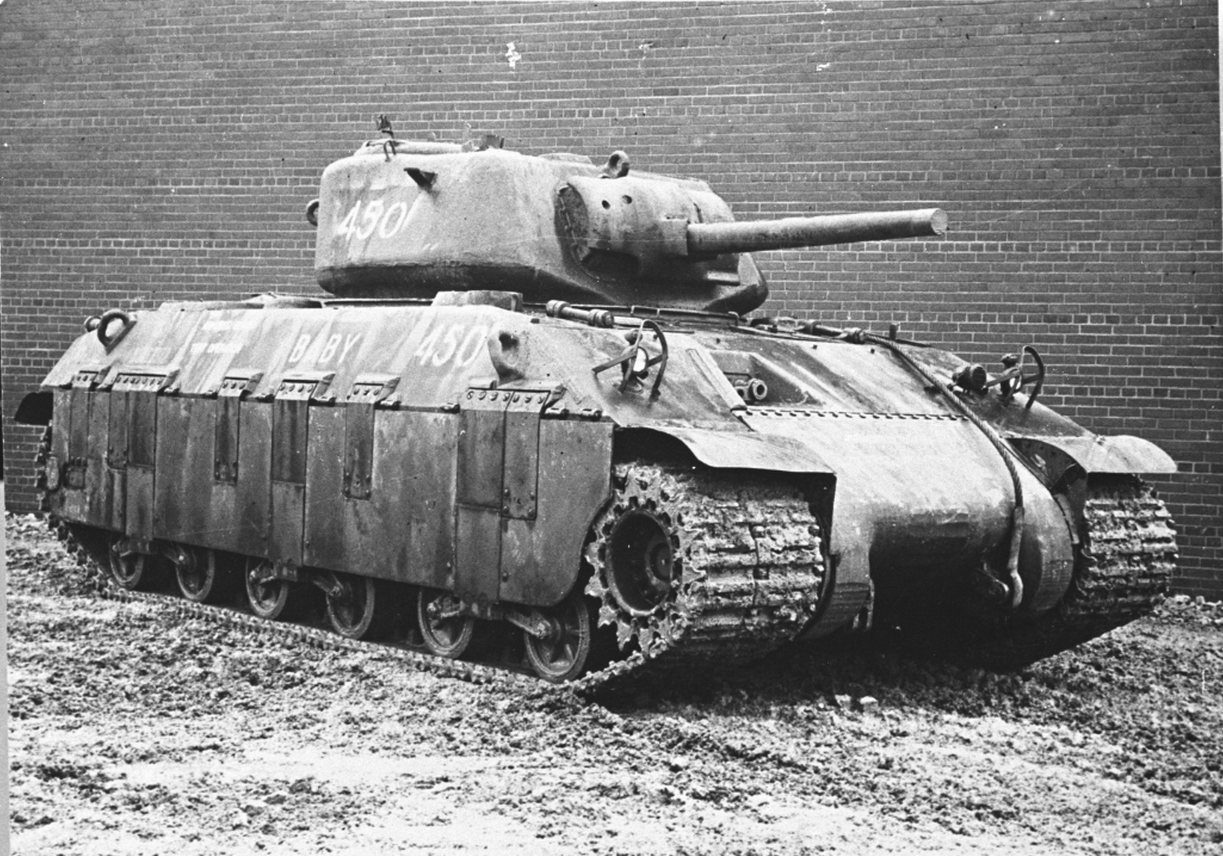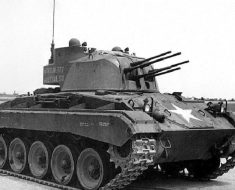Many will know the T14 from its appearances in popular video games like World of Tanks and Warthunder, where it is well-angled armor makes it a tough nut to crack. Fortunately for players though, they do not have to worry about the T14’s other real-life attributes, such as its weight, difficult steering, and poor reliability.
The tank was developed early into WWII by the United States specifically at Britain’s request, and combined features from the Sherman and M6 heavy tank.
While this may sound like a match made in heaven, this was far from the case. Looking like a fat, squished Sherman, the T14 proved to be a rather poor design with a number of problems.
The US never liked the T14, and by the time Britain had finished testing it they no longer needed it, discarding it along with their own version, the A33.
This is the story of the T14 Assault Tank.
Contents
- Background
- Development
- The T14
- Performance
- Conclusion
Background
At the start of the Second World War Britain had a distinct doctrine for its armored forces, which was comprised of tanks in three categories; light tanks, cruiser tanks and infantry tanks.
The theory behind how these tanks would work together is as follows: light tanks were small, lightly armed and thinly armored, and would perform reconnaissance. Infantry tanks were heavily armored and would assist attacking troops in smashing a hole in the enemy’s lines. Finally, the cruiser tanks, with adequate armor and more potent guns would rush through the hole and attack the enemy in the chaos behind the lines.
This thinking influenced Britain’s tanks throughout the war.

One such vehicle was the Churchill, a tank built precisely for the infantry tank role. It was the most heavily armored British tank produced during the war, but from the very moment of its entry into service in 1941 British General Staff were worried that it was too slow and unreliable.
To solve this potential issue ahead of time, Britain started making plans for a new tank that had decent mobility and could take a beating. As they lacked the capacity to build such a vehicle themselves on a large scale, they looked to the manufacturing might of the USA.
In March 1942, representatives from Britain met with US officials to finalise the requirements for a new “assault tank” that would pick up the Churchill’s slack.
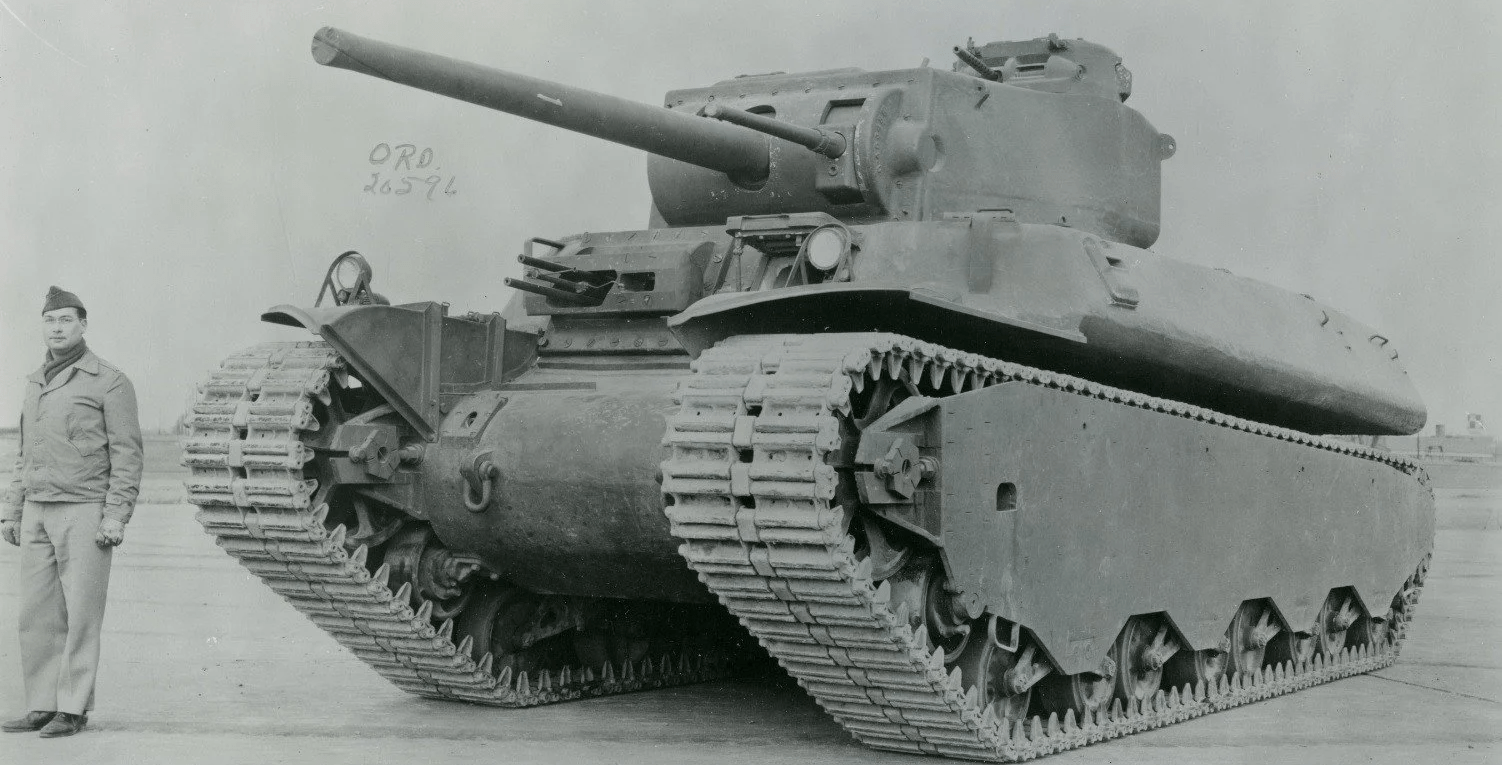
The US had actually already drafted some basic plans for such a vehicle after previous meetings in 1941 indicated that Britain really wanted tanks of this type. These early plans, which took inspiration from the M6 heavy tank and incorporated many components from the Sherman, would be the basis of this new project.
It was no small project either, as Britain was looking to receive over 8,000 assault tanks.
Read More The US T29 – a 70 Ton Beast Built to Battle Tigers
The US showed little interest in the design but Britain was desperate, so detailed plans for the vehicle were drawn up over the next few months by Aberdeen Proving Ground. It was designated T14.
At the same time Britain got to work creating its own version, designed to meet the exact same requirements as laid out for the T14 to ensure that they had a backup if the US tank failed.
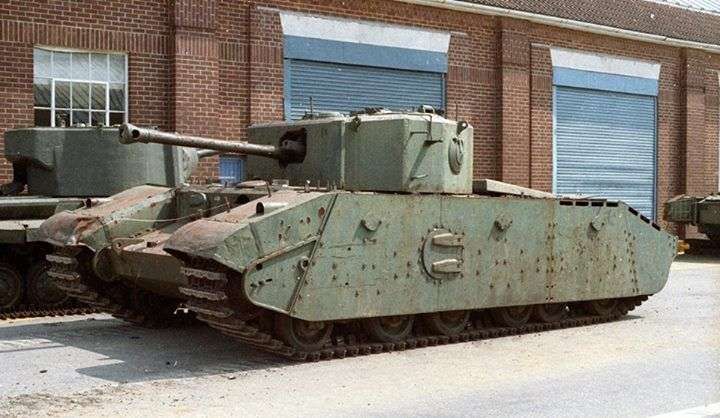
Britain’s interpretation was based on the Cromwell cruiser tank, which was still in development at the time. This tank was designated A33, and is often given the name Excelsior. It must be noted though that no documents actually mention the word Excelsior, suggesting that it never actually had this name.
The US and Britain agreed to produce two prototypes each, and send one of them to the other. They would retain the second for their own testing.
Development
As the US already had the basic plans for an assault tank based on Britain’s needs, they were much further ahead with the project. The overall design of the T14 was finished in June 1942, and by November a wooden mock-up was built.
The American Locomotive Company (ALCO) was selected to produce the two working prototypes.
The first prototype was delivered to Aberdeen Proving Ground in July 1943, and the second arrived in August.

The T14’s final shape is an odd one, resembling an M4 Sherman that has been squished down into a wider, shorter and more squat vehicle. And to be fair, this is not far from the case, as the design was influenced by the Sherman, but incorporated much more armor angling.
The US trialed the T14 themselves for a few months, before sending one of them to Britain in 1944 for further trials.
The T14
As an assault tank there was a large emphasis on the T14’s survivability, so while it may have had a somewhat similar appearance to the Sherman, its armor was much better all around.
Like a Sherman, the T14’s upper hull sides extended outwards over the tracks, providing more room inside the tank but also increasing the amount of space needing protection. This portion was 51 mm thick – compared to 38 mm on the Sherman – and sloped back at 30 degrees to further increase its effectiveness.
The rear was also 51 mm thick, although set at less of a slope than the sides.
At the front the actual armor thickness remained mostly the same, but with much greater angles to. The upper glacis was 51 mm thick, angled back at 60 degrees. This produced an effective thickness of 102 mm, equivalent to the Tiger I.
The differential housing had a maximum of 102 mm of armor across its nose.

Meanwhile, the turret was protected by some genuinely impressive armor; 75 mm on the front, sloped back at 30 degrees, and 102 mm all over the sides and rear. This meant the T14’s turret was actually better protected than the Tiger I’s in most areas.
The lower sides of the hull were covered by 12.7 mm thick plating. This was added at British request to counter high explosive anti-tank (HEAT) rounds, and gives the T14 its unique, tortoise-shell look. Combined with the 63 mm thick armor behind the suspension, the T14’s sides were certainly well protected for the day.
It was fitted with a horizontal volute spring suspension system, which was taken from the M6 heavy tank, along with its 650 mm wide steel cleat tracks.
The tank came in at a weight of 42 tons – compared to 33 tons of the Sherman – so the wide tracks were necessary to stop the T14 from bogging down in soft ground.
Powering this beast was a Ford GAZ V8 engine, which produced around 520 hp. This was mated to the same transmission system as used in the M4 Sherman, although the final drives were modified to reduce the T14’s speed. It was able to reach a good road speed of 24 mph, and a maximum off-road speed of 13 mph.

The armament also followed the Sherman’s lead, with the T14 receiving the same 75 mm M3, although provisions were made for the tank to accept the British 6-pounder gun if needed. It was reportedly also built with 76, 90 and 105 mm guns in mind too, although work never progressed to this point.
The 75 mm was housed in an M34A1 gun mantlet taken from the Sherman, and was accompanied by a coaxial .30 caliber machine gun.
Read More Black Prince – The Ultimate Churchill Tank
It had a .30 caliber hull machine gun too, though unlike the Sherman’s ball mount it incorporated a dedicated gun sight next to the machine gun. According to some sources, the hull gun was originally meant to be a .50 caliber, but was then adapted to receive a .30 caliber.
It was noted by the British that the hull machine gun created a weak point in the tank’s armor, but no changes were made to the prototypes.
Performance
So the Americans had built a 42-ton machine that could travel at 24 mph, and engage enemy targets all while being well protected; how did it fair in trials? Unfortunately, not very well.
As mentioned, the US put the T14 through their own tests at the Aberdeen Proving Ground in the closing half of 1943 before sending one to Britain. They found that the tank had poor maneuverability and was unreliable, suffering from issues with its tracks and suspension that were then difficult to fix due to the side skirts.
The testing staff recommended that the US should not pursue the T14. Still, the first prototype was sent to Britain, where they carried out their own tests in 1944. Once again, it was not good news.
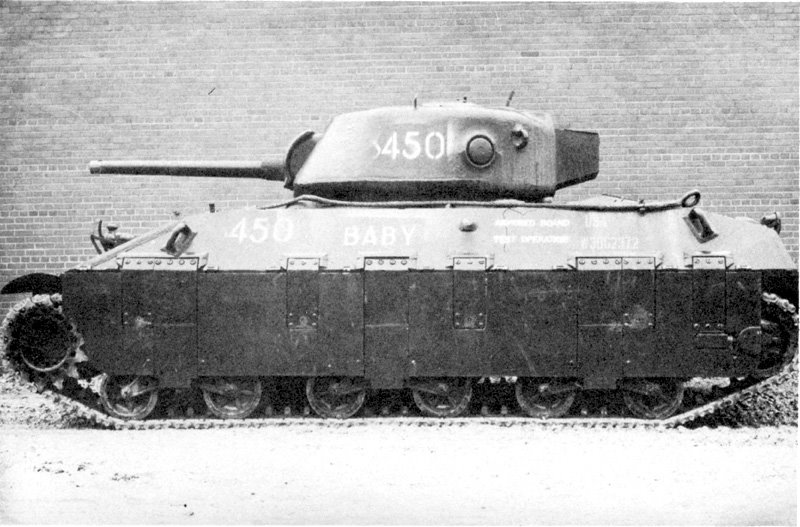
Trials at the Fighting Vehicles Proving Establishment (FVPE) at Chertsey in the UK put the tank through a 930-mile course of roads, hills and mud. A large number of defects were encountered during the trial relating to most major areas on the tank, however the T14’s Ford GAZ engine had a particularly large list of issues.
This included the partial seizure of the engine, which then had to be replaced, and frequent problems caused by the distributor and its subsequent bodged repairs. The second engine was soon found to be cracked, but as the spare had already been used they had to make repairs using parts from both engines.
Later on, problems with the engine’s fans led to it overheating until it warped. This engine was then replaced by a third. Less than 100 miles later and the engine was overheating again, warping the cylinder heads which then had to be skimmed.
The issues with the GAZ V8 are surprising as the engine was known for being reliable. In fact, even the trial report notes that this engine in the T14 was more problematic than when it was used in Shermans.

The transmission prop shaft snapped too after the tank rolled backward on a hill in first gear. The T14 also showed some track and suspension problems, although these weren’t too terrible, suffering from similar issues to the Sherman.
When in mud the T14 was found to be seriously hard to turn, with the driver sometimes needing a second man to assist on the controls.
Overall the tests were able to identify a number of drawbacks with the T14 design, although many of these are not unusual for a prototype and would have likely been rectified before or during production. However issues inherent in the design, like its weight and difficulty to operate and repair weren’t such easy fixes.
Conclusion
Unfortunately for the T14 though, by the time Britain was done evaluating it the war had changed massively; the Churchill proved itself to be an excellent and dependable machine, and a tank like the T14 was no longer needed. Instead, Britain was looking toward faster tanks with more powerful guns, a line of thinking that would culminate in tanks like the Comet and Centurion.
The US had long established that they weren’t interested in the tank, and with Britain on the same page, the project was canceled in December 1944. Britain’s A33 went the same way.

The T14 prototype was scrapped in the US, but the second lives on today in the Vehicle Conservation Centre at The Tank Museum, Bovington. The cherry on top of the cake is that parked in front of the T14, is a surviving A33 prototype.
Read More The TV1000 Rhino – A 6×6 V8 Powered Beast
It is warming to know that these two tanks, built more than 70 years ago by two separate nations for the exact same job, will spend the rest of their time together in one place.
